| Listing 1 - 10 of 10 |
Sort by
|

Abstract | Keywords | Export | Availability | Bookmark
 Loading...
Loading...Choose an application
- Reference Manager
- EndNote
- RefWorks (Direct export to RefWorks)
Caves. --- Civilization, Subterranean. --- Excavations (Archaeology). --- Speleology. --- Underground areas. --- Underground construction.
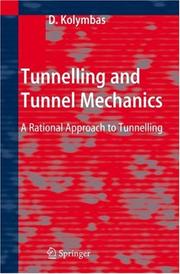
ISBN: 1280306378 9786610306374 1601199619 3540285008 3540251960 3642064361 9783540251965 Year: 2005 Publisher: Berlin ; New York : Springer,
Abstract | Keywords | Export | Availability | Bookmark
 Loading...
Loading...Choose an application
- Reference Manager
- EndNote
- RefWorks (Direct export to RefWorks)
The book covers not only practical aspects but also the underlying theoretical approaches. It also covers the fundamentals of rock mechanics. It addresses not only students but also professionals who are interested to understand the underlying principles and methods and – possibly – to further develop them. Emphasis is given to the mechanical approach rather than to hardly tractable empirical statements. The text is concise and comprises a large list of citations. Publications of the English and German speaking scientific communities have been taken into account.
Tunneling. --- Rock mechanics. --- Geotechnical engineering --- Mechanics --- Earthwork --- Engineering --- Mining engineering --- Rock excavation --- Underground construction --- Excavation --- Tunnels --- Design and construction --- Rock mechanics --- Tunneling --- geotechniek --- grondmechanica --- grouten --- kunstmatige grondbevriezing --- stabiliteitsstudie --- tunnelbeheer --- tunnelbouw --- tunnelgraafmachine --- tunnelwand --- Hydraulic engineering. --- Mechanics, applied. --- Geotechnical Engineering & Applied Earth Sciences. --- Geoengineering, Foundations, Hydraulics. --- Theoretical and Applied Mechanics. --- Applied mechanics --- Engineering, Mechanical --- Engineering mathematics --- Engineering, Hydraulic --- Fluid mechanics --- Hydraulics --- Shore protection --- Geotechnical engineering. --- Engineering geology. --- Engineering—Geology. --- Foundations. --- Hydraulics. --- Mechanics. --- Mechanics, Applied. --- Classical mechanics --- Newtonian mechanics --- Physics --- Dynamics --- Quantum theory --- Flow of water --- Water --- Hydraulic engineering --- Jets --- Architecture --- Building --- Structural engineering --- Caissons --- Masonry --- Soil consolidation --- Soil mechanics --- Walls --- Civil engineering --- Geology, Economic --- Engineering, Geotechnical --- Geotechnics --- Geotechnology --- Engineering geology --- Flow --- Distribution --- Details --- Geology
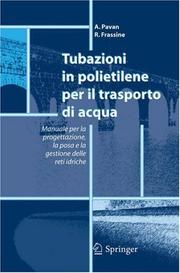
ISBN: 8847002680 9786611349356 1281349356 8847003563 Year: 2005 Publisher: Milano : Springer,
Abstract | Keywords | Export | Availability | Bookmark
 Loading...
Loading...Choose an application
- Reference Manager
- EndNote
- RefWorks (Direct export to RefWorks)
L’esigenza di quest’opera nasce dalla necessità di raccogliere, integrare e rendere disponibile agli operatori del settore la notevole cultura tecnica disponibile riguardo all’utilizzo del polietilene nel settore di reti idriche. Il polietilene, un materiale estremamente versatile che non dà luogo a corrosione e formazione di incrostazioni, flessibile, leggero e facilmente saldabile, offre notevoli vantaggi prestazionali ed economici nella realizzazione di reti per il trasporto di acqua. Il manuale fornisce un quadro completo e aggiornato delle caratteristiche dei materiali, dei metodi di progettazione della tubazione, delle tecniche di posa, dei metodi di giunzione, delle tecniche di riabilitazione di condotte esistenti e delle norme di riferimento tecniche di prodotto e di certificazione. La realizzazione del manuale è stata affidata a Andrea Pavan, docente del Politecnico di Milano e direttore scientifico della Fondazione Laboratorio Prove Materie Plastiche (POLI.lampol), che è stato coadiuvato da Roberto Frassine, docente dello stesso Politecnico. La necessità di adeguare le reti per il trasporto di acqua alle esigenze del Paese rende quest’opera un indispensabile strumento operativo per i progettisti e per tutti gli operatori del settore interessati a trarre vantaggio dalle potenzialità offerte da questo materiale.
Hydraulic engineering. --- Polyethylene -- Italy. --- Water transfer -- Technological innovations -- Italy. --- Water-supply -- Italy. --- Water-supply engineering -- Italy. --- Hydraulic Engineering --- Civil Engineering --- Civil & Environmental Engineering --- Mechanical Engineering --- Engineering & Applied Sciences --- Water-supply engineering --- Engineering, Water-supply --- Engineering, Hydraulic --- Engineering. --- Engineering geology. --- Engineering --- Foundations. --- Hydraulics. --- Geoengineering, Foundations, Hydraulics. --- Engineering, general. --- Geology. --- Civil engineering --- Hydraulic engineering --- Water --- Fluid mechanics --- Hydraulics --- Shore protection --- Purification --- Construction --- Industrial arts --- Technology --- Engineering—Geology. --- Flow of water --- Jets --- Architecture --- Building --- Structural engineering --- Underground construction --- Caissons --- Earthwork --- Masonry --- Soil consolidation --- Soil mechanics --- Walls --- Geology, Economic --- Flow --- Distribution --- Details --- Geology
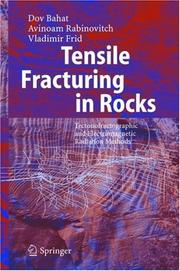
ISBN: 1280234601 9786610234608 3540266143 3540214569 3642059872 Year: 2005 Publisher: Berlin ; New York : Springer,
Abstract | Keywords | Export | Availability | Bookmark
 Loading...
Loading...Choose an application
- Reference Manager
- EndNote
- RefWorks (Direct export to RefWorks)
‘Tensile Fracturing in Rocks’ presents field observations on fracturing of sedim- tary rocks and granite outcrops from various provinces in three continents. It also combines results of recent experiments conducted at different laboratories around the world with current theories on fracturing. In treating faults, this book limits itself to faults that are associated with joint sets produced by definable causes and occasi- ally to cases where interaction between the two types of fracture – faults and joints – is not clear. The book’s subject matter is divided over six chapters, which are briefly described below. Chapter 1 summarizes current key concepts in fracture physics. It starts with a pr- entation of the elastic theory of fracture, and concentrates on the results of linear el- tic fracture mechanics. The chapter touches also upon other fracture properties, e.g., crack nucleation, dynamic fracturing and slow fracturing processes. Nucleation is - dressed by statistical mechanics methods incorporating modern approaches of th- mal and fiber bundle processes. The analyses of dynamic fracturing and slow fract- ing focus on the differences, as compared to the linear elastic approach. The cont- versy in interpreting experimental dynamic results is highlighted, as are the surface morphology patterns that emerge in fracturing and the non-Griffith crack extension criterion in very slow fracturing processes.
Rocks --- Granite outcrops --- Geology, Structural. --- Fractography. --- Electromagnetic waves. --- Fracture. --- Testing. --- Electromagnetic energy --- Electromagnetic radiation --- Electromagnetic theory --- Waves --- Rock mechanics --- Microfractography --- Electron microscopy --- Fracture mechanics --- Metallography --- Metals --- Geotectonics --- Structural geology --- Tectonics (Geology) --- Physical geology --- Granite --- Outcrops (Geology) --- Petrology --- Stone --- Fracture --- Hydraulic engineering. --- Mineralogy. --- Geology. --- Physical geography. --- Structural Geology. --- Geoengineering, Foundations, Hydraulics. --- Geophysics/Geodesy. --- Hydrogeology. --- Geography --- Geognosy --- Geoscience --- Earth sciences --- Natural history --- Crystallography --- Minerals --- Engineering, Hydraulic --- Engineering --- Fluid mechanics --- Hydraulics --- Shore protection --- Structural geology. --- Engineering geology. --- Engineering—Geology. --- Foundations. --- Hydraulics. --- Geophysics. --- Geohydrology --- Geology --- Hydrology --- Groundwater --- Geological physics --- Terrestrial physics --- Physics --- Flow of water --- Water --- Hydraulic engineering --- Jets --- Architecture --- Building --- Structural engineering --- Underground construction --- Caissons --- Earthwork --- Masonry --- Soil consolidation --- Soil mechanics --- Walls --- Civil engineering --- Geology, Economic --- Flow --- Distribution --- Details

ISBN: 1280337591 9786610337590 3540273034 3540231110 3642062067 Year: 2005 Publisher: Berlin : Springer,
Abstract | Keywords | Export | Availability | Bookmark
 Loading...
Loading...Choose an application
- Reference Manager
- EndNote
- RefWorks (Direct export to RefWorks)
The Engineer and the Scandal gives an in-depth study into an important part of the development of the Theory of Porous Media as well as the amazing story of the glittering life of Professor Karl von Terzaghi. It provides an outline of the bitter dispute between him and Professor Paul Fillunger, both working at the Technische Hochschule of Vienna, Austria, in the fields of soil mechanics and technical mechanics during the 1930s. The ugly confrontation with its tragic end was a scandal in many respects. The author, a well-known scientist himself in the field of the mechanics of porous media, investigated this piece of science history in Austria, Norway, and the United States of America. He discloses an amazing story which has been nearly forgotten although it produced large headlines in the Vienna of 1937.
Engineers --- Soil mechanics --- Terzaghi, Karl, --- Soil engineering --- Soils --- Soils (Engineering) --- Geotechnical engineering --- Mechanics --- Foundations --- Soil physics --- Engineering personnel --- Terzaghi, K. von --- Von Terzaghi, K. --- Mechanics. --- Mechanics, Applied. --- Hydraulic engineering. --- Science (General). --- Mathematics. --- Solid Mechanics. --- Geoengineering, Foundations, Hydraulics. --- Popular Science, general. --- Geotechnical Engineering & Applied Earth Sciences. --- Applications of Mathematics. --- Science, Humanities and Social Sciences, multidisciplinary. --- Math --- Science --- Engineering, Hydraulic --- Engineering --- Fluid mechanics --- Hydraulics --- Shore protection --- Applied mechanics --- Engineering, Mechanical --- Engineering mathematics --- Classical mechanics --- Newtonian mechanics --- Physics --- Dynamics --- Quantum theory --- Engineering geology. --- Engineering—Geology. --- Foundations. --- Hydraulics. --- Popular works. --- Geotechnical engineering. --- Applied mathematics. --- Engineering mathematics. --- Engineering analysis --- Mathematical analysis --- Engineering, Geotechnical --- Geotechnics --- Geotechnology --- Engineering geology --- Flow of water --- Water --- Hydraulic engineering --- Jets --- Architecture --- Building --- Structural engineering --- Underground construction --- Caissons --- Earthwork --- Masonry --- Soil consolidation --- Walls --- Civil engineering --- Geology, Economic --- Mathematics --- Flow --- Distribution --- Details --- Geology
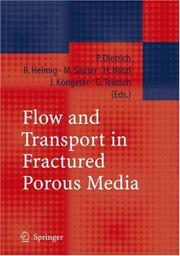
ISBN: 1280346752 9786610346752 3540270124 3540232702 3642062318 Year: 2005 Publisher: Berlin ; New York : Springer,
Abstract | Keywords | Export | Availability | Bookmark
 Loading...
Loading...Choose an application
- Reference Manager
- EndNote
- RefWorks (Direct export to RefWorks)
This book addresses the characterization of flow and transport in porous fractured media from experimental and modeling perspectives. The volume explores porous media problems, from the origin of the present natural porous structures, to their characterization, and various flow and transport phenomena that exist within the porous media. Examples are miscible displacements in porous media and fractured rock and the physical and chemical interactions within porous fractured aquifers. The book is a comprehensive presentation of investigations performed and analysed on different scales, supporting the understanding and application of experimental studies and numerical simulations.
Porous materials --- Fluid dynamics. --- Mathematical models. --- Porous media --- Materials --- Porosity --- Mechanics. --- Mechanics, Applied. --- Hydraulic engineering. --- Environmental sciences. --- Environmental pollution. --- Solid Mechanics. --- Engineering Fluid Dynamics. --- Geoengineering, Foundations, Hydraulics. --- Math. Appl. in Environmental Science. --- Waste Water Technology / Water Pollution Control / Water Management / Aquatic Pollution. --- Hydrogeology. --- Chemical pollution --- Chemicals --- Contamination of environment --- Environmental pollution --- Pollution --- Contamination (Technology) --- Asbestos abatement --- Bioremediation --- Environmental engineering --- Environmental quality --- Factory and trade waste --- Hazardous waste site remediation --- Hazardous wastes --- In situ remediation --- Lead abatement --- Pollutants --- Refuse and refuse disposal --- Environmental science --- Science --- Engineering, Hydraulic --- Engineering --- Fluid mechanics --- Hydraulics --- Shore protection --- Applied mechanics --- Engineering, Mechanical --- Engineering mathematics --- Classical mechanics --- Newtonian mechanics --- Physics --- Dynamics --- Quantum theory --- Environmental aspects --- Fluid mechanics. --- Engineering geology. --- Engineering—Geology. --- Foundations. --- Hydraulics. --- Water pollution. --- Flow of water --- Water --- Hydraulic engineering --- Jets --- Architecture --- Building --- Structural engineering --- Underground construction --- Caissons --- Earthwork --- Masonry --- Soil consolidation --- Soil mechanics --- Walls --- Civil engineering --- Geology, Economic --- Hydromechanics --- Continuum mechanics --- Geohydrology --- Geology --- Hydrology --- Groundwater --- Aquatic pollution --- Fresh water --- Fresh water pollution --- Freshwater pollution --- Inland water pollution --- Lake pollution --- Lakes --- Reservoirs --- River pollution --- Rivers --- Stream pollution --- Water contamination --- Water pollutants --- Water pollution --- Waste disposal in rivers, lakes, etc. --- Flow --- Distribution --- Details
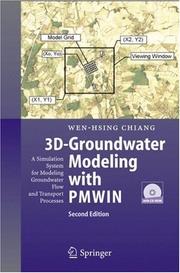
ISBN: 1280306467 9786610306466 3540275924 3540275908 Year: 2005 Publisher: Berlin ; New York : Springer,
Abstract | Keywords | Export | Availability | Bookmark
 Loading...
Loading...Choose an application
- Reference Manager
- EndNote
- RefWorks (Direct export to RefWorks)
Processing Modflow is one of the most complete three-dimensional groundwater and transport simulation systems in the world. The text and the companion full-version software (PMWIN) offer a totally integrated simulation system. PMWIN comes with a professional graphical user-interface, supported models and programs and several other useful modeling tools. The graphical user-interface allow one to create and simulate models with ease and fun. It can import DXF- and raster graphics and handle models with up to 1000 stress periods, 80 layers and 250,000 cells in each model layer. The model tools include a Presentation Tool, a Result Extractor, a Field Interpolator, a Field Generator, a Water Budget Calculator and a Graphic Viewer. Book targeted at novice and experienced groundwater modelers. The typical user is working as a hydrogeological or environmental consultant, in a water company, in a regulatory agency or a university.
Groundwater flow --- Groundwater --- Computer simulation. --- Pollution --- Ground water --- Subterranean water --- Underground water --- Water, Underground --- Water --- Hydrogeology --- Geology. --- Geography. --- Hydraulic engineering. --- Environmental pollution. --- Geomorphology. --- Earth Sciences, general. --- Hydrology/Water Resources. --- Geoengineering, Foundations, Hydraulics. --- Waste Water Technology / Water Pollution Control / Water Management / Aquatic Pollution. --- Chemical pollution --- Chemicals --- Contamination of environment --- Environmental pollution --- Contamination (Technology) --- Asbestos abatement --- Bioremediation --- Environmental engineering --- Environmental quality --- Factory and trade waste --- Hazardous waste site remediation --- Hazardous wastes --- In situ remediation --- Lead abatement --- Pollutants --- Refuse and refuse disposal --- Engineering, Hydraulic --- Engineering --- Fluid mechanics --- Hydraulics --- Shore protection --- Cosmography --- Earth sciences --- World history --- Geognosy --- Geoscience --- Natural history --- Environmental aspects --- Earth sciences. --- Hydrology. --- Engineering geology. --- Engineering—Geology. --- Foundations. --- Hydraulics. --- Water pollution. --- Civil engineering --- Geology, Economic --- Aquatic sciences --- Hydrography --- Geosciences --- Environmental sciences --- Physical sciences --- Geomorphic geology --- Physiography --- Physical geography --- Landforms --- Aquatic pollution --- Fresh water --- Fresh water pollution --- Freshwater pollution --- Inland water pollution --- Lake pollution --- Lakes --- Reservoirs --- River pollution --- Rivers --- Stream pollution --- Water contamination --- Water pollutants --- Water pollution --- Waste disposal in rivers, lakes, etc. --- Flow of water --- Hydraulic engineering --- Jets --- Architecture --- Building --- Structural engineering --- Underground construction --- Caissons --- Earthwork --- Masonry --- Soil consolidation --- Soil mechanics --- Walls --- Geology --- Flow --- Distribution --- Details
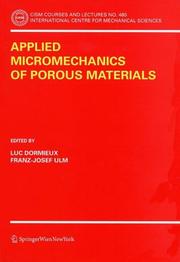
ISBN: 9783211380468 3211263624 9783211263624 3211380469 Year: 2005 Publisher: Vienna : Springer Vienna : Imprint: Springer,
Abstract | Keywords | Export | Availability | Bookmark
 Loading...
Loading...Choose an application
- Reference Manager
- EndNote
- RefWorks (Direct export to RefWorks)
Poromechanics is the mechanics of porous materials and is now a well established field in many engineering disciplines, ranging from Civil Engineering, Geophysics, Petroleum Engineering to Bioengineering. However, a rigorous approach that links the physics of the phenomena at stake in porous materials and the macroscopic behaviour is still missing. This book presents such an approach by means of homogenization techniques. Rigorously founded in various theories of micromechanics, these up scaling techniques are developed for the homogenization of transport properties, stiffness and strength properties of porous materials. The special feature of this book is the balance between theory and application, providing the reader with a comprehensive introduction to state-of-the-art homogenization theories and applications to a large range of real life porous materials: concrete, rocks, shales, bones, etc.
Engineering. --- Physics and Applied Physics in Engineering. --- Continuum Mechanics and Mechanics of Materials. --- Engineering Thermodynamics, Transport Phenomena. --- Structural Foundations, Hydraulic Engineering. --- Applied Geosciences. --- Biophysics/Biomedical Physics. --- Biomedical engineering. --- Materials. --- Ingénierie --- Génie biomédical --- Matériaux --- Micromechanics. --- Porous materials -- Mechanical properties. --- Porous materials. --- Porous media --- Geotechnical engineering. --- Biophysics. --- Biological physics. --- Thermodynamics. --- Heat engineering. --- Heat transfer. --- Mass transfer. --- Continuum mechanics. --- Engineering geology. --- Engineering --- Foundations. --- Hydraulics. --- Engineering, general. --- Engineering Thermodynamics, Heat and Mass Transfer. --- Geoengineering, Foundations, Hydraulics. --- Geotechnical Engineering & Applied Earth Sciences. --- Biophysics and Biological Physics. --- Geology. --- Materials --- Porosity --- Composite materials --- Solid state physics --- Microstructure --- Mechanics. --- Mechanics, Applied. --- Hydraulic engineering. --- Solid Mechanics. --- Biological and Medical Physics, Biophysics. --- Engineering, Hydraulic --- Fluid mechanics --- Hydraulics --- Shore protection --- Applied mechanics --- Engineering, Mechanical --- Engineering mathematics --- Classical mechanics --- Newtonian mechanics --- Physics --- Dynamics --- Quantum theory --- Construction --- Industrial arts --- Technology --- Engineering—Geology. --- Chemistry, Physical and theoretical --- Mechanics --- Heat --- Heat-engines --- Biological physics --- Biology --- Medical sciences --- Engineering, Geotechnical --- Geotechnics --- Geotechnology --- Engineering geology --- Flow of water --- Water --- Hydraulic engineering --- Jets --- Architecture --- Building --- Structural engineering --- Underground construction --- Caissons --- Earthwork --- Masonry --- Soil consolidation --- Soil mechanics --- Walls --- Civil engineering --- Geology, Economic --- Mass transport (Physics) --- Thermodynamics --- Transport theory --- Heat transfer --- Thermal transfer --- Transmission of heat --- Energy transfer --- Mechanical engineering --- Flow --- Distribution --- Details --- Geology
Book
ISBN: 9781402038808 1280411740 9786610411740 1423749308 1402038801 Year: 2005 Publisher: Dordrecht Springer
Abstract | Keywords | Export | Availability | Bookmark
 Loading...
Loading...Choose an application
- Reference Manager
- EndNote
- RefWorks (Direct export to RefWorks)
"Maurice Schwartz has brought forth a new volume with a fresh interdisciplinary approach that includes geomorphology, ecology, engineering, technology, oceanography, and human activities as they relate to coasts. Within its cover the Encyclopedia of Coastal Science includes many aspects of the coastal sciences that are only to be found scattered among scientific literature." "Being broadly interdisciplinary in its treatment of coasts, the Encyclopedia of Coastal Science features contributions by 245 international specialists in their respective fields and is illustrated with line-drawings and photographs. Not only does this volume offer an extensive number of entries, it also includes various appendices, an illustrated glossary of coastal geomorphology and extensive bibliographic listings. This encyclopedia thus provides a comprehensive reference work for students, professionals as well as informed lay readers."--Jacket
hydrobiologie --- Underground structures. Earthwork --- hydraulica --- milieubeheer --- klimatologie --- meteorologie --- Physical geography --- Meteorology. Climatology --- Hydrosphere --- fysische geografie --- Hydrobiology --- Environmental protection. Environmental technology --- oceanografie --- Oceanography. --- Climatology. --- Engineering geology. --- Engineering --- Foundations. --- Hydraulics. --- Environment. --- Physical geography. --- Aquatic ecology . --- Geoengineering, Foundations, Hydraulics. --- Environment, general. --- Physical Geography. --- Freshwater & Marine Ecology. --- Geology. --- Aquatic biology --- Ecology --- Flow of water --- Water --- Fluid mechanics --- Hydraulic engineering --- Jets --- Architecture --- Building --- Structural engineering --- Underground construction --- Caissons --- Earthwork --- Masonry --- Soil consolidation --- Soil mechanics --- Walls --- Climate --- Climate science --- Climate sciences --- Science of climate --- Atmospheric science --- Civil engineering --- Geology, Economic --- Geography --- Oceanography, Physical --- Oceanology --- Physical oceanography --- Thalassography --- Earth sciences --- Marine sciences --- Ocean --- Flow --- Distribution --- Details --- Geology --- Coastal engineering --- Coastal ecology --- Engineering—Geology. --- Balance of nature --- Biology --- Bionomics --- Ecological processes --- Ecological science --- Ecological sciences --- Environment --- Environmental biology --- Oecology --- Environmental sciences --- Population biology --- Geomorphology --- Oceanography --- Geomorphic geology --- Physiography --- Landforms --- Coastal zone management --- Shore protection --- Coast ecology --- Coastal zone ecology --- Coasts --- Coastal biology --- Sublittoral ecology --- Freshwater ecology. --- Marine ecology. --- Ocean Sciences. --- Climate Sciences. --- Geoengineering. --- Environmental Sciences. --- Freshwater and Marine Ecology. --- Biological oceanography --- Marine ecosystems --- Aquatic ecology --- Fresh water --- Fresh-water ecology

ISBN: 3642060781 3540222464 9786610346950 1280346957 3540268472 Year: 2005 Publisher: Berlin ; New York : Springer,
Abstract | Keywords | Export | Availability | Bookmark
 Loading...
Loading...Choose an application
- Reference Manager
- EndNote
- RefWorks (Direct export to RefWorks)
This volume addresses the issue of uncertainty in civil engineering from design to construction. Failures do occur in practice. Attributing them to a residual system risk or a faulty execution of the project does not properly cover the range of causes. A closer scrutiny of the adopted design, the engineering model, the data, the soil-construction-interaction and the model assumptions is required. Usually, the uncertainties in initial and boundary conditions are abundant. Current engineering practice often leaves these issues aside, despite the fact that new scientific tools have been developed in the past decades that allow a rational description of uncertainties of all kinds, from model uncertainty to data uncertainty. It is the aim of this volume to have a critical look at current engineering risk concepts in order to raise awareness of uncertainty in numerical computations, shortcomings of a strictly probabilistic safety concept, geotechnical models of failure mechanisms and their implications for construction management, execution, and the juristic question of responsibility. In addition, a number of the new procedures for modelling uncertainty are explained. The book is a result of a collaborate effort of mathematicians, engineers and construction managers who met regularly in a post graduate seminar at the University of Innsbruck during the past years.
Civil engineering. --- Construction industry -- Risk management. --- Reliability (Engineering). --- Structural failures. --- Structural failures --- Construction industry --- Reliability (Engineering) --- Civil engineering --- Engineering & Applied Sciences --- Civil & Environmental Engineering --- Chemical & Materials Engineering --- Mechanical Engineering --- Technology - General --- Industrial & Management Engineering --- Civil Engineering --- Materials Science --- Risk management --- Risk management. --- Reliability of equipment --- Systems reliability --- Collapse of structures --- Failures, Structural --- Engineering. --- Geotechnical engineering. --- Probabilities. --- Statistics. --- Mechanics. --- Mechanics, Applied. --- Quality control. --- Reliability. --- Industrial safety. --- Engineering geology. --- Engineering --- Foundations. --- Hydraulics. --- Quality Control, Reliability, Safety and Risk. --- Geotechnical Engineering & Applied Earth Sciences. --- Probability Theory and Stochastic Processes. --- Statistics for Engineering, Physics, Computer Science, Chemistry and Earth Sciences. --- Theoretical and Applied Mechanics. --- Geoengineering, Foundations, Hydraulics. --- Geology. --- Public works --- Maintainability (Engineering) --- Probabilities --- Systems engineering --- Plant performance --- Safety factor in engineering --- Deformations (Mechanics) --- Fracture mechanics --- Structural stability --- System safety. --- Distribution (Probability theory. --- Mechanics, applied. --- Hydraulic engineering. --- Engineering, Hydraulic --- Fluid mechanics --- Hydraulics --- Shore protection --- Applied mechanics --- Engineering, Mechanical --- Engineering mathematics --- Statistical analysis --- Statistical data --- Statistical methods --- Statistical science --- Mathematics --- Econometrics --- Distribution functions --- Frequency distribution --- Characteristic functions --- Safety, System --- Safety of systems --- Systems safety --- Accidents --- Industrial safety --- Prevention --- Statistics . --- Engineering—Geology. --- Flow of water --- Water --- Hydraulic engineering --- Jets --- Architecture --- Building --- Structural engineering --- Underground construction --- Caissons --- Earthwork --- Masonry --- Soil consolidation --- Soil mechanics --- Walls --- Geology, Economic --- Classical mechanics --- Newtonian mechanics --- Physics --- Dynamics --- Quantum theory --- Probability --- Statistical inference --- Combinations --- Chance --- Least squares --- Mathematical statistics --- Risk --- Engineering, Geotechnical --- Geotechnics --- Geotechnology --- Engineering geology --- Industrial accidents --- Industries --- Job safety --- Occupational hazards, Prevention of --- Occupational health and safety --- Occupational safety and health --- Prevention of industrial accidents --- Prevention of occupational hazards --- Safety, Industrial --- Safety engineering --- Safety measures --- Safety of workers --- System safety --- Dependability --- Trustworthiness --- Conduct of life --- Factory management --- Industrial engineering --- Sampling (Statistics) --- Standardization --- Quality assurance --- Quality of products --- Flow --- Distribution --- Details --- Geology
| Listing 1 - 10 of 10 |
Sort by
|

 Search
Search Feedback
Feedback About UniCat
About UniCat  Help
Help News
News